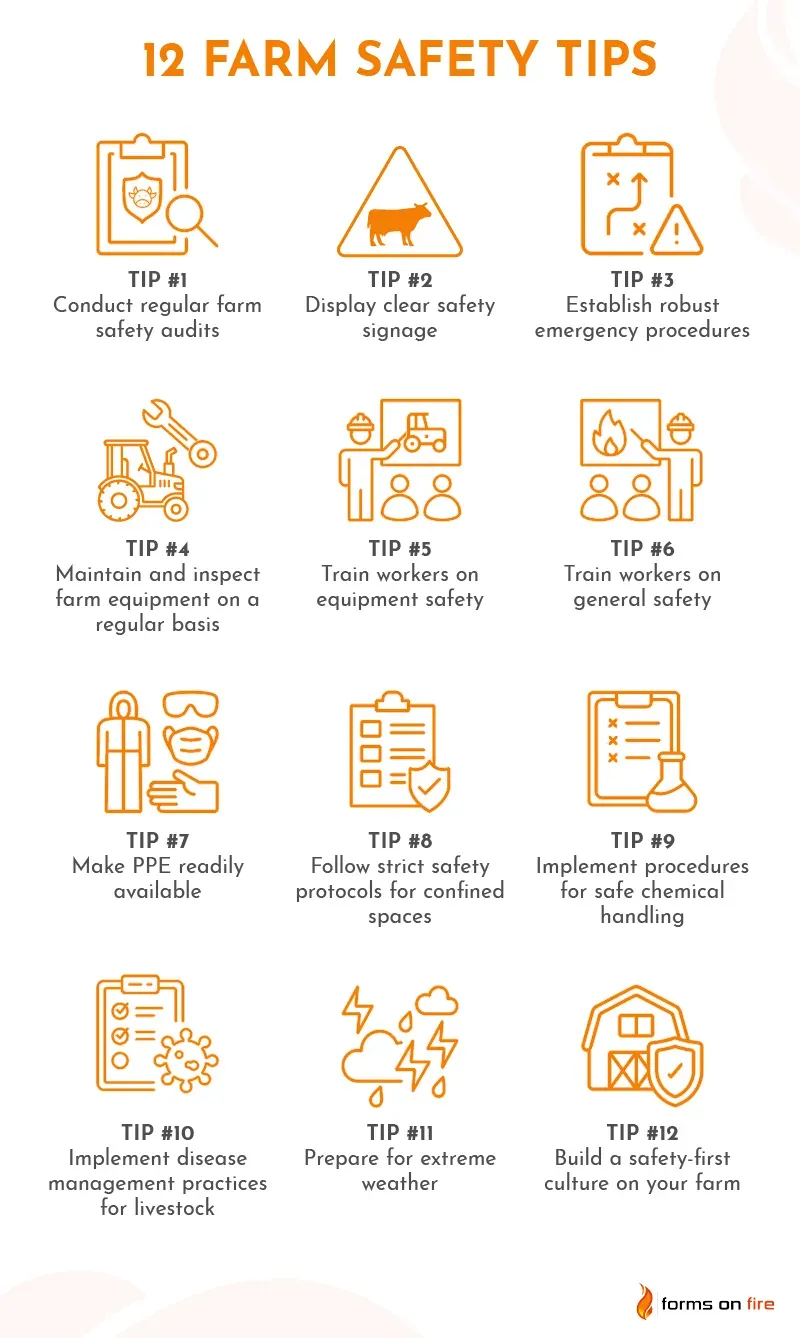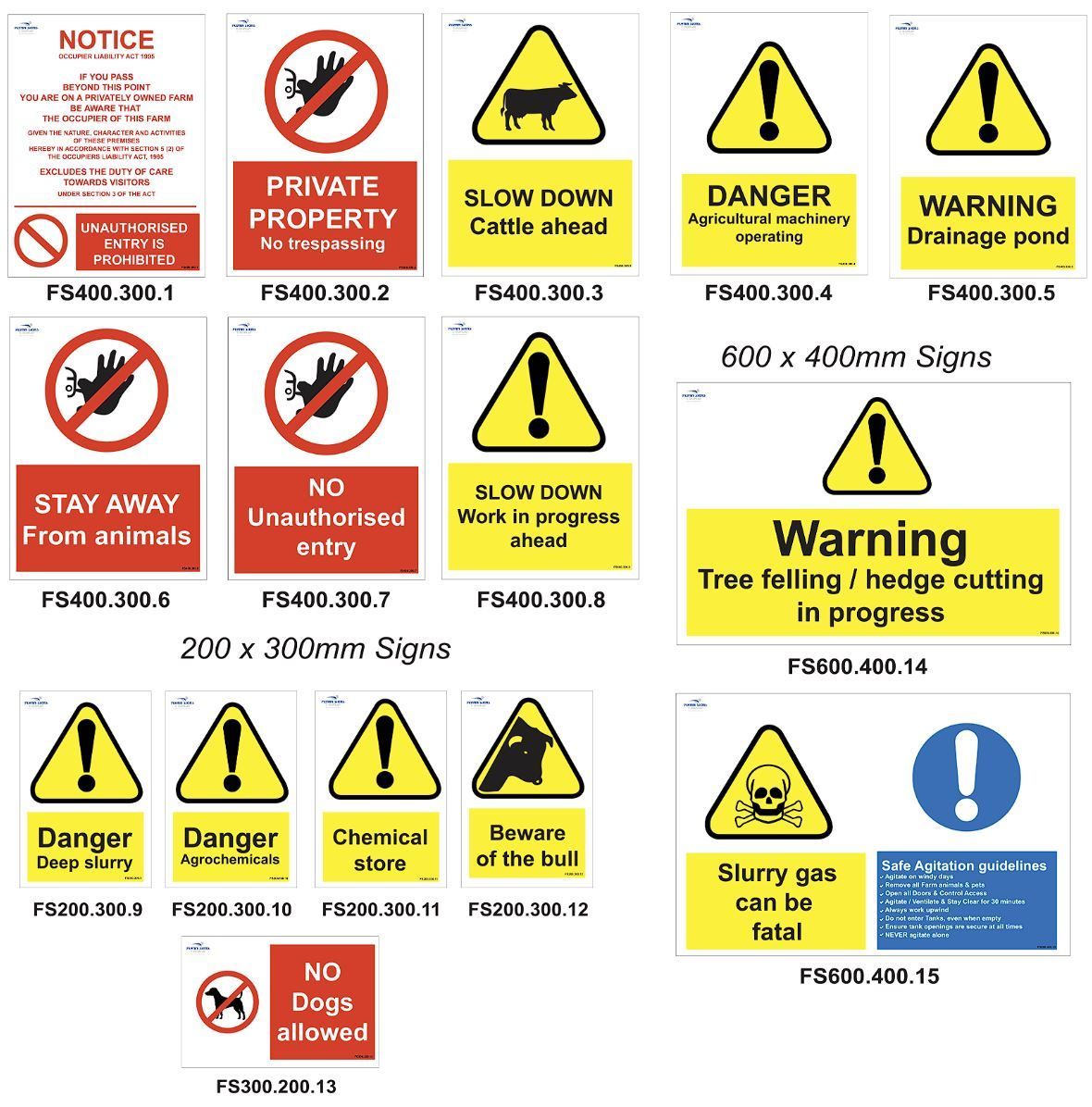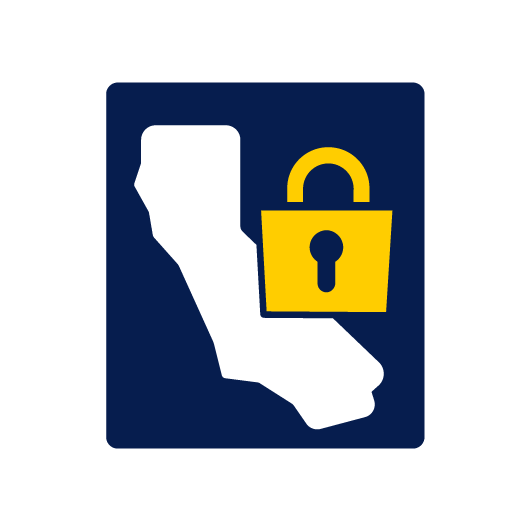12 Farm Health and Safety Tips You Can Start Implementing Today
Despite advances in technology and safety practices, farms remain challenging and sometimes dangerous environments.
According to data from the NIOSH, between 2021-2022, there were 21,020 injuries in agricultural production that required days away from work. And those are just the officially reported injuries.
With just a little more focus on farm safety, those numbers could be way down. So, in this article, we will provide 12 practical, actionable farm health and safety advice designed to reduce risks and protect farm workers.
Before that, let's get to know thine enemy by quickly overviewing the most common farm hazards.
The most common farm hazards to watch out for
Recognizing potential hazards is the first step in preventing accidents and ensuring a safer working environment. Here are some of the most prevalent dangers found on farms:
- Machinery and equipment: Farm machinery is indispensable but can also be deadly. Tractors, combines, balers, and other heavy machinery account for the majority of fatal farm accidents. For example, tractor overturns are the single deadliest type of farming accident.
- Chemicals: Pesticides and fertilizers are essential for modern agriculture but handling them improperly can lead to poisoning, burns, respiratory issues, and other serious health problems.
- Confined spaces: Structures like silos and manure pits pose serious risks due to the potential for suffocation or exposure to toxic gases.
- Livestock: Animals can be unpredictable and dangerous. Injuries from kicks, bites, or being pinned between an animal and a hard place are common and can be severe.
- Falls: Working at height on ladders, barn lofts, and other elevated platforms can lead to falls, which are among the most common causes of farm injury.
- Weather and environmental conditions: Farmers often work in extreme conditions, from scorching heat to freezing cold, which can lead to heatstrokes or hypothermia. Additionally, working in fields can expose workers to allergens and dust, leading to respiratory issues.
By recognizing the dangers, farmers and farm managers can implement specific measures to mitigate these risks, which we'll explore in the following farm safety tips.

Tip #1: Conduct regular farm safety audits
Regular safety audits are essential in identifying potential hazards that could lead to injuries or fatalities on the farm.
- Develop a checklist: Create a comprehensive checklist that covers all areas of your farm. This should include machinery, chemical storage, animal housing, and worker facilities. Tailor this checklist to the specifics of your operations.
- Schedule audits regularly: Safety audits should be conducted at regular intervals, at least bi-annually, or as seasons change and different operations come into play.
- Involve your team: Make safety audits a team effort. Involving workers can provide additional insights and helps to reinforce a culture of safety. Each member can be assigned a specific area to inspect, based on their expertise and daily duties.
- Use technology: Leverage technology to streamline the audit process. Digital tools and mobile apps like Forms On Fire allow you to create digital checklists that can be shared instantly across your team and used to capture data offline. This not only makes the process more efficient but also ensures that no critical information is lost or overlooked.
- Act on findings: Any hazards identified should be addressed promptly. Create an action plan for resolving issues and set deadlines for their completion.
- Keep records: Maintain records of all safety audits, including the date of the audit, findings, actions taken, and the outcome of those actions. This documentation can be vital for regulatory compliance and useful in understanding trends over time.
These steps, combined with other types of farm audits, is the most straightforward way to ensure regulatory compliance and create a safe working environment.
Tip #2: Display clear safety signage
Clear, visible signs can alert workers to potential hazards, guide them in emergency procedures, and provide crucial information at a glance.
Walk through your farm to identify areas where safety signs are most needed. Place them at eye level and in well-lit areas to ensure they are easily visible. They should be made of durable materials that can withstand heavy sunlight, rain, and dirt.
Here are some examples of safety signs you can find on a farm:
- Biohazard signs: For areas where there is exposure to harmful biological substances.
- Prohibition signs: Such as "No Smoking" in areas where flammable materials are stored.
- Warning signs: Like "High Voltage" for areas with electrical equipment.
- Mandatory action signs: Like "Use Handrail" on staircases or "Wear Ear Protection" in high-noise areas.

Tip #3: Establish robust emergency procedures
Having emergency plans can significantly reduce the severity of accidents and speed up the response during critical situations.
Here’s how to set up effective emergency procedures on your farm:
- Assess potential emergencies: Start by identifying the types of emergencies most likely to occur on your farm, such as chemical spills, machinery accidents, fires, or severe weather events.
- Develop clear action plans: For each identified emergency, develop a specific action plan. This should include steps to prevent escalation, methods to protect workers and animals, and procedures to secure machinery and chemicals.
- Install emergency equipment: Equip your farm with necessary emergency tools and equipment, such as fire extinguishers, first aid kits, spill containment kits, and emergency alarms.
- Train all employees: This training should cover how to use emergency equipment, evacuation routes, and special procedures for high-risk areas. Refresher courses and drills should be conducted annually to keep everyone sharp.
- Establish an alert system: Have a reliable communication system in place to alert everyone on the farm in the event of an emergency. This might include alarms, loudspeakers, or even mobile alerts.
- Post emergency information: In addition to safety signage, post emergency procedures prominently in all key areas of the farm. This includes maps showing evacuation routes and locations of emergency equipment.
This might seem like a lot of work at first, but considering the number of injuries that happen on farms each day, it’s more than worth it.
Tip #4: Maintain and inspect farm equipment on a regular basis
Let’s imagine you have a tractor with a malfunctioning Power Take-Off (PTO) shaft. The safety guard, meant to shield the rotating shaft, was damaged and not replaced during routine maintenance. While John was clearing debris near the tractor, his jacket became caught in the still-spinning shaft, pulling him in and causing severe arm injuries.
This is just one of many examples of faulty equipment being dangerous equipment.
To prevent that, perform regular maintenance checks on all major farm equipment. This schedule should include daily, weekly, and seasonal checks, depending on the machinery's usage and manufacturer's recommendations.
We recommend implementing a standardized checklist for machinery inspections. This list should cover all critical components of each piece of equipment, such as brakes, tires, hydraulics, and safety guards.
Again, you can use tools like Forms On Fire to digitize these checklists, track maintenance history, and even create equipment maintenance schedules.
Tip #5: Train workers on equipment safety
The training should cover starting and stopping procedures, proper use of controls, and the correct usage of any personal protective equipment required for operating the machinery.
One of the lessons should specifically address the importance of machine guards, which are critical for preventing injuries from moving parts. Train workers to check that guards are in place and properly secured before using any equipment.
Remember, while classroom-style training is a good starting point, nothing beats hands-on practice under the supervision of experienced operators.
Tip #6: Train workers on general safety
All workers should learn the basics like:
- First aid and CPR
- Ladder safety (selecting the right ladder for the job, proper placement, and safety while climbing)
- Fire safety (how to use fire extinguishers and the different types of extinguishers for various kinds of fires)
- Emergency response procedures (steps to follow based on the type of emergency)
- The proper use and maintenance of Personal Protective Equipment (PPE).
Knowing these simple things can have a huge positive impact on overall farm safety.
Tip #7: Make PPE readily available
Here is a quick list of different types of PPE and their specific uses in farming:
- Leather gloves: Used for handling equipment, doing construction, or working with barbed wire to protect against cuts and scratches.
- Chemical-resistant gloves: Necessary when applying pesticides or handling other hazardous chemicals to prevent skin absorption of harmful substances.
- Safety goggles: Protect against dust, debris, and chemical splashes that occur during activities like grinding, welding, or chemical application.
- Face shields: Used in conjunction with goggles for extra protection against chemicals or when working with machinery that might project objects.
- Dust masks: Simple masks for protection against dust and particulates during tasks like harvesting or working in dusty conditions.
- Earplugs and Earmuffs: Essential when operating loud machinery such as tractors, combines, or chainsaws to prevent hearing damage.
- Coveralls and overalls: Provide a barrier against minor spills and keep clothes clean; some are designed to be chemical-resistant.
- Steel-toed boots: Protect feet from heavy objects and accidents with machinery. Many also offer slip-resistant soles for stability on uneven or slippery surfaces.
- Helmets or hard hats: Protect against head injuries from falling objects or accidental bumps against hard surfaces.
The exact range of PPE you should have on your farm will depend on the type of operations and equipment you’re running.
Tip #8: Follow strict safety protocols for confined spaces
Confined spaces on farms, such as grain bins, silos, and manure pits, pose significant risks due to their restricted exits and the potential for hazardous atmospheres.
Following strict safety protocols for entering and working in these spaces is crucial to prevent accidents and fatalities. One way to do that is to provide workers with a Confined space entry checklist they can follow.
On top of that, proper safety equipment and training are indispensable.
Tip #9: Implement procedures for safe chemical handling
Proper management and handling of chemicals are critical on farms to prevent accidents, environmental damage, and health issues.
For detailed guidelines on storing, handling, and disposing of farm chemicals safely, here is a good resource from BetterHealth.
As an alternative, here is a great 2-minute video overview form Work Safe SA:
Tip #10: Implement disease management practices for livestock
Effective disease management is essential to maintain the health of livestock and prevent the spread of infectious diseases. Here are some key practices:
- Regular health screenings: Schedule regular health checks by veterinarians to monitor the health of the herd or flock. Early detection of diseases through screenings can help isolate sick animals and prevent larger outbreaks.
- Vaccination programs: Develop and maintain a comprehensive vaccination program based on the specific risks to your livestock.
- Nutrition and water quality: Ensure that animals have access to clean water and a balanced diet. This strengthens their immune system and reduces susceptibility to diseases.
- Pest control: Implement effective pest control measures to reduce the risk of disease transmission by vectors such as rodents, flies, and ticks.
- Record keeping: Maintain detailed health records for all animals, including their medical history, treatments, vaccinations, and any signs of illness. This data is crucial for managing health at the herd level and for traceability in case of disease outbreaks.
Tip #11: Prepare for extreme weather
Extreme weather events can disrupt operations and pose serious risks to both workers and livestock.
Consider developing a comprehensive emergency plan tailored to different types of weather scenarios. This plan should include evacuation routes, emergency shelter areas for animals and workers, and procedures for securing or moving equipment and livestock.
You should also have a reliable way to alert workers of impending extreme weather and to coordinate actions during emergencies. This could include text alerts, loudspeakers, or two-way radios.
Of course, all of that is predicated on keeping up with weather forecasts. These days, farmers can use weather apps and subscribe to local alert systems to receive timely warnings about extreme weather.
Tip #12: Build a safety-first culture on your farm
A safety-first culture starts at the top. Farm owners and managers must not only enforce safety policies but also actively participate in and advocate for safety practices. Their commitment sets the tone for the rest of the staff.
Clear safety policies, open communication about safety issues, handling near-misses seriously, and regular safety training are the hallmarks of a safety-first culture.
This will be way easier to achieve if you introduce new employees to the farm’s safety culture from day one. Orientation should cover basic safety protocols, introduce them to safety resources, and emphasize the farm’s commitment to safety.
By building a safety-first culture, you not only protect your workers and operations but also enhance productivity and morale. A farm where everyone feels safe is one where everyone can focus on doing their best work.
Improve farm safety with Forms On Fire
Forms On Fire is a mobile forms platform that can significantly enhance farm safety management by streamlining data collection, audits, and reporting processes.
Farmers use it for:
- Digital safety checklists: Replace paper-based safety checklists with digital forms that can be accessed from any mobile device. This ensures all safety procedures are followed thoroughly and consistently.
- Simplifying regular audits: You can customize forms to include specific safety criteria relevant to different areas of the farm. Auditors can fill these out directly on their tablets or smartphones, even while offline, and sync the data once they are back online.
- Incident reporting: Workers can quickly fill out incident reports on their devices, attach photos, and submit them instantly, shortening the response time.
- Training records and compliance: Keep track of training sessions and ensure compliance with safety regulations by using FoF to record attendance and participation.
- Maintenance schedules: Schedule and track maintenance for farm equipment. Set reminders for upcoming maintenance checks and use the app to log maintenance work.
- Data analysis and improvement: Collect and analyze safety data to identify trends and areas for improvement. Generate reports easily and make data-driven decisions to enhance overall farm safety.
As a no-code platform, Forms On Fire can be used to build almost any digital tool you need to streamline farm management and safety. Learn more by starting a free trial or getting a product demo.
Company
Contact
Platform
Resources
Use Cases
Industries




